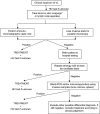The relationship between leishmaniasis and AIDS: the second 10 years
- PMID: 18400800
- PMCID: PMC2292576
- DOI: 10.1128/CMR.00061-07
The relationship between leishmaniasis and AIDS: the second 10 years
Abstract
To date, most Leishmania and human immunodeficiency virus (HIV) coinfection cases reported to WHO come from Southern Europe. Up to the year 2001, nearly 2,000 cases of coinfection were identified, of which 90% were from Spain, Italy, France, and Portugal. However, these figures are misleading because they do not account for the large proportion of cases in many African and Asian countries that are missed due to a lack of diagnostic facilities and poor reporting systems. Most cases of coinfection in the Americas are reported in Brazil, where the incidence of leishmaniasis has spread in recent years due to overlap with major areas of HIV transmission. In some areas of Africa, the number of coinfection cases has increased dramatically due to social phenomena such as mass migration and wars. In northwest Ethiopia, up to 30% of all visceral leishmaniasis patients are also infected with HIV. In Asia, coinfections are increasingly being reported in India, which also has the highest global burden of leishmaniasis and a high rate of resistance to antimonial drugs. Based on the previous experience of 20 years of coinfection in Europe, this review focuses on the management of Leishmania-HIV-coinfected patients in low-income countries where leishmaniasis is endemic.
Figures


References
-
- Akilov, O. E., A. Khachemoune, and T. Hasan. 2007. Clinical manifestations and classification of Old World cutaneous leishmaniasis. Int. J. Dermatol. 46:132-142. - PubMed
-
- Akuffo, H., K. Maasho, M. Blostedt, B. Hojeberg, S. Britton, and M. Bakhiet. 1997. Leishmania aethiopica derived from diffuse leishmaniasis patients preferentially induce mRNA for interleukin-10 while those from localized leishmaniasis patients induce interferon-gamma. J. Infect. Dis. 175:737-741. - PubMed
-
- Akuffo, H., E. Schurr, G. Andersson, T. Yamaneberhan, and S. Britton. 1987. Responsiveness in diffuse versus local cutaneous leishmaniasis is due to parasite differences. Scand. J. Immunol. 26:717-721. - PubMed
-
- Albrecht, H. 1998. Leishmaniosis—new perspectives on an underappreciated opportunistic infection. AIDS 12:2225-2226. - PubMed
Publication types
MeSH terms
Substances
LinkOut - more resources
Full Text Sources
Other Literature Sources
Medical

